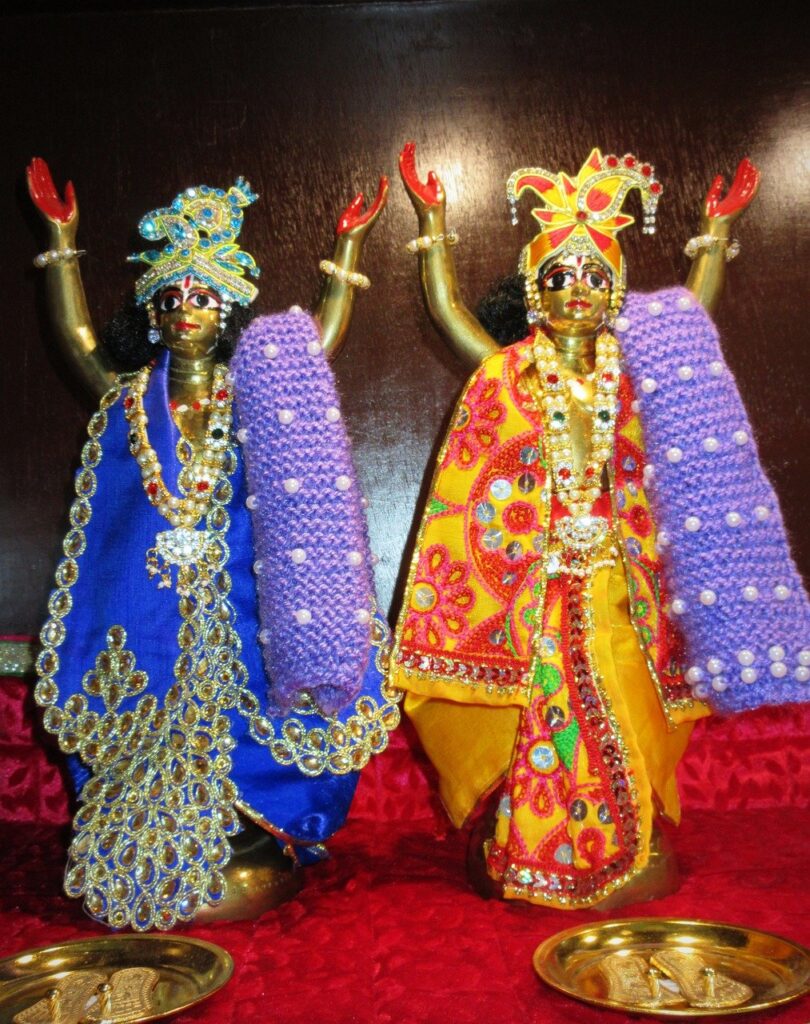
A Hindu temple is not a communal place of worship, but rather the abode of God or a specific deity, which is why it is often referred to as a ‘devasthan’ or ‘devalaya’. The activities within the temple revolve around serving and worshiping the deity. The worship is performed by a designated priest or group of priests. The temple serves as a meeting place for humans and gods, providing a space for people to move from ignorance to knowledge and truth. According to Indian tradition, a town or village without a temple is deemed uninhabitable. One of the main purposes of the temple is to create a spiritually charged atmosphere, which is why they are often built on sacred sites. During quiet periods, the temple offers a peaceful setting for contemplation, while during busier times, it is bustling with activity. Temples come in all sizes, ranging from small outdoor shrines to humble village mandirs, to large and elaborate temples that serve as the center of an ashram, with many Brahman priests residing within or nearby.
Even though God is present everywhere, a temple holds special significance because He is not easily perceptible unless one has a spiritual vision. The temple provides an environment where the dormant spiritual nature of individuals can thrive. Additionally, it offers an opportunity for individuals to associate with and seek guidance from priests or experienced devotees who can assist them in achieving their spiritual aspirations. When visiting a Hindu temple, the primary focus of a devotee should not be to pray for personal benefits but rather to fully engage in the service of the ultimate reality.
6 Things to know about visiting a Hindu temple
#1 Temple Etiquette
Since a temple is considered as the abode of God, it is appropriate to maintain an attitude of humility and modesty when visiting one. It is recommended to wear clean and simple clothing when entering a temple. In the past, Indian kings would travel in palanquins, but it is considered improper to enter a temple with one’s shoes on or in a palanquin. Regardless of one’s social status, qualifications, or abilities, it is important to abandon any attitude of superiority or dominance and adopt the mentality of being a servant of the servant of the Lord.

After entering the temple, it is customary to offer obeisances or bow down as a sign of respect to both the devotees and the deity, recognizing that the divine grace flows through the devotees. Then, one should take darshan of the deities while praising their captivating forms with an attitude of submission. Hindus typically bring an offering of flowers, fruit, or other items when visiting a temple. While sitting on the temple floor, it is recommended to keep one’s feet covered and avoid sitting with one’s back to the deities whenever possible. It is also important to refrain from using harsh language, lying, or quarreling in the presence of the deity.
#2 Hindu Deity Worship
The Lord exists beyond our ordinary senses. Our eyes cannot see Him, nor can our ears hear Him. Only to the extent that we have dedicated ourselves to the Lord’s service or have freed ourselves from sin, can we perceive Him. However, even if we have not yet achieved this state, the Lord is merciful enough to allow us to see Him in the form of His deity in the temple. The Lord is omnipotent and can accept our service through the manifestation of His deity form. He has complete control over all energies, whether material or spiritual. He can transform matter into spirit and vice versa. Therefore, we should not consider the deity in the temple to be a mere stone or wooden idol. The deity form of the Lord is not an idol, but the Lord Himself, and the extent to which we have purified ourselves from sin determines our ability to comprehend the deity’s significance.

As a result, deities in Hindu temples are revered and considered indistinguishable from the Lord. The temple priest’s relationship with the Lord determines how they engage in the deity’s service. In most cases, the worship of deities in Hindu temples is a deeply personal affair. The deity’s clothing is changed regularly, food is offered, and darshan is closed every day when the deities rest. On festive or special occasions, musicians, singers, and other performers entertain the deities.
Hindus believe that true worship is not just about visiting the temple once a week to seek forgiveness for wrongdoings. Real worship is immersive and engages all senses in the service of the Supreme. While true Divinity exists in everything and can be meditated on at any time and place, having a physical form to worship is essential to engage all senses in worship.
Deities are created following specific scriptural guidelines that have been passed down for generations by skilled artisan lineages. In a temple, one can see the deity’s form, smell the flowers and incense, feel the water and light, taste the food, and hear the sound of the bell ringing during puja. In this way, all of one’s senses can become spiritually awakened.
#3 Mantra Meditation and Congregational Chanting
Mantra meditation is a widely practiced Hindu tradition, where devotees use a string of beads made from natural substances to chant the name of their chosen deity. This type of meditation is aimed at purifying the mind, body and actions, and ultimately, connecting with the Supreme. Additionally, this practice is often used in music as kirtan, where one person leads the chanting and others respond in harmony. Through group chanting, a potent kinship is created that uplifts people of all backgrounds.

According to the revered Hindu text Srimad Bhagavatam, the most important quality of the present age is the ability to attain liberation from contamination and reunite with the Lord by chanting His holy names. The holy name of the Lord is considered non-different from the Lord, and chanting regularly is the primary means to attain divine love and transcend the material world. It is the means, method, and accomplishment of spiritual practice. The power of chanting the holy names is so great that one can attain the same benefits that were previously achieved through meditation, sacrifices, and service to the Lord’s lotus feet in other ages.
#4 Temples at Home
Having temples at home can serve as a powerful tool for spiritualizing one’s dwelling and living in harmony with Dharmic principles. A place where deities are worshiped becomes transformed into a temple, and this is why it is common for Hindus to have an altar in their homes where they can pay homage to their deities. The size and grandeur of the altar may vary depending on the space available, and the standards of worship may not be as strict as those of a traditional temple.

While certain rituals, such as changing the deity’s clothes daily, may not be followed with the same rigor as in a temple, the essence of worship remains unchanged. Having a temple room in the house offers an easily accessible place to meditate and worship, which can help individuals live a more spiritually conscious life. Moreover, it can inspire people to keep their homes clean and lead a regulated life, reducing the temptation to indulge in sense gratification. Ultimately, having a temple at home is a beautiful way to integrate spirituality into one’s daily life and create a sacred space for contemplation and worship. It is a reminder of the divine presence in our homes and the importance of aligning our actions with higher principles.
#5 Spiritual Guidance
A daily spiritual practice, also known as sadhana in Hinduism, is crucial for individuals seeking to make genuine progress on the path of transcendence. Although having a temple in one’s home can provide a sense of engagement, it can still be challenging to maintain self-discipline. Similar to how schools motivate students to study, visiting a temple can help individuals stay focused on their spiritual life.

The lack of association with fellow devotees can make it incredibly difficult for individuals to escape the illusionary energy of the Supreme Lord, known as Maya. As the Bhagavad Gita teaches, this Maya is exceptionally tough for individuals to overcome alone (mama maya duratyaya). However, those who surrender themselves to the Supreme Lord and seek His divine shelter can quickly achieve this challenging objective (mam eva ye prapadyante mayam etam taranti te). The association of fellow devotees is significant as it reminds individuals of the potential negative consequences of leading a materialistic life and inspires them to engage in devotional service towards the Supreme Lord. Thus, a consistent spiritual practice, combined with the support of fellow devotees, is essential for those who aspire to progress on the path of transcendence.
#6 From Trading with to Loving God
Hinduism is not uniform, but rather a multiform religion that caters to the diverse consciousness of its devotees. Various deities, such as the Sun as the giver of light, Indra as the giver of rain, Ganesh as the God of success, and Lakshmi as the goddess of fortune, represent different aspects of God. However, worshiping God solely for the fulfillment of one’s material needs amounts to the worship of the gifts bestowed upon us by the divine, rather than the divine itself. This type of relationship with God, based on a trade of material desires, is not true divine love, but rather lust, which hinders the cultivation of a deeper connection with God.

Beyond this level of materialistic worship, there exists a higher platform where God is viewed as the object of heartfelt devotion. As an individual’s spiritual consciousness gradually evolves, they establish a more profound and personal relationship with the divine. In this way, Hinduism caters to the spiritual evolution of its followers, providing a path towards a deeper understanding and connection with God.
There are five types of relationships that such an advanced devotee may possess with the Supreme Lord:
- Neutrality – In this type of relationship, the devotee feels neither affection towards the Lord nor attachment to the world. This is exemplified by sages such as the four Kumaras.
- Servitude – The devotee sees themselves as a servant of the Lord. Garuda has this kind of relationship with Lord Vishnu, while Hanuman serves Lord Rama.
- Friendship – In this type of relationship, the devotee approaches the Supreme Lord as a friend. Arjuna shares this kind of relationship with Lord Krishna.
- Parent-child – The devotee views the Lord as their own child. Nanda and Yashoda had this type of relationship with Krishna.
- Lover – The devotee approaches the Lord as their beloved. Rukmini and Radha exemplify this kind of relationship with Krishna.
Each of these relationships represents a different aspect of devotion, and individuals may find themselves drawn to one or more of these relationships in their pursuit of a deeper connection with the Supreme Lord. Ultimately, the goal of devotion is to cultivate an unwavering love and devotion for the Lord, regardless of the type of relationship one may possess.